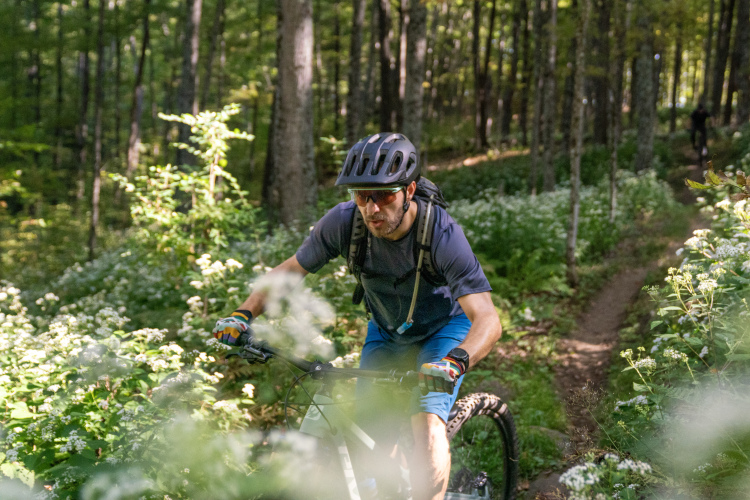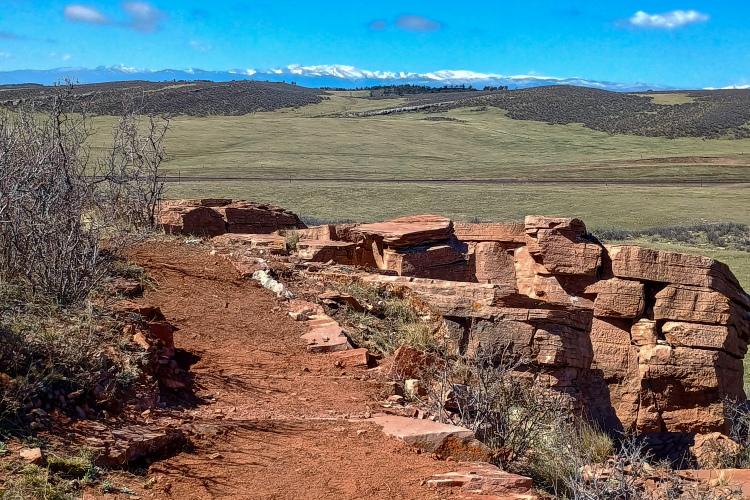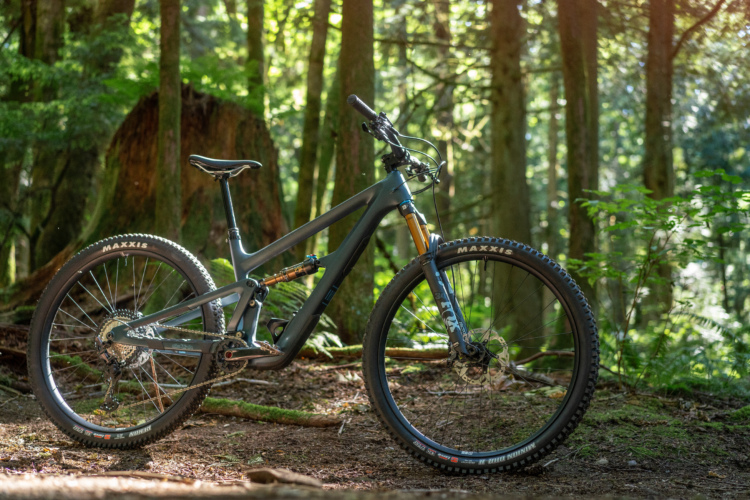Finding a bike that fits is crucial to enjoying the sport of mountain biking. A well-fitting bike will handle better on the trail, and of course be more comfortable for longer rides.
When I first shopped for a mountain bike, I looked at just the standover height, which is exactly what the name implies. As long as I had enough room for the boys, I was good. However, I am 5′ 8″ with a stubby 29″ inseam, a fairly long torso and normal length arms. Since I was using only standover height as my “fit” guide, I would generally end up with a bike that was too small in other measurements, and thereforeuncomfortableto ride and unstable on the trail. The trick is to take all of the bike measurements into account, rather than focusing on any one. Also, each builder uses different frame dimensions, so bikes of the same nominal size, but from different brands, will fit differently.
Illustration credit:Kona Bikes
When looking at a mountain bike geometry chart, there are three measurements that affect how the bike will fit:
- Seat tube length
- Top tube length
- Standover height
The seat tube length can be measured a couple of ways, but in either case it is usually given as the nominal size of the bike. For example, a 16″ could be a small, an 18″ a medium, and so forth.
Top tube length is the distance measured from the steerer to the intersection with the seat tube. With modern bikes employing fancy curved top tubes, some makers list both the actual and the effective, or straight line measurement for this. If only one length is listed, it is usually the effective length.
Standover height is obviously just the height from the top tube down to the ground.
For getting a good fit on a bike, in very basic terms, we are looking for a bike that allows good leg extension while pedaling, anaggressive, but comfortable reach to the handlebars, and enough room to not hurt yourself if you come off the pedalsunexpectedly.

Illustration credit:Bikes Direct
Seat Tube
In my opinion the top tube is thecriticalmeasurement, but most sizing starts with the seat tube length. When pedaling, your leg should extendnot quite all the way at the bottom of the pedal travel, but also not squish into your gut on the upswing. For mountain biking, you also want to leave some room to be able to lower the seat for technical downhill sections, so go with a size that allows a decent range of seat post adjustment. If you have only a couple inches of seatpost showing, go a size smaller. If you have a 400mm seatpost extended all the way to the warning line, go a size bigger.
Effective Top Tube
The top tube length will affect your reach from the saddle to the bars. Mountain biking benefits from an ‘aggressive’ position, which means you will be slightly stretched out when seated. This position allows for optimum counter effort to your pedaling force from pulling on the handlebars. If your top tube length is too long, you’ll go past the sweet spot forefficient power transfer, and most likely suffer from lower back pain and have difficulty steering the bike where you want it to go. Too short and you will find yourself going over the handlebars … a lot. Once you get a top tube length that is close, you can fine tune the fit with a longer or shorter stem. Just like the seatpost though, if you find yourself needing anextremely short or long stem, go up or down a frame size.
Standover
I’ve been informed by girl riders that this isn’texclusivelya boy problem. The general rule of thumb is to be able to stand flat-footed and have an inch or so of space between you and the top tube. However …. If you have a really short inseam, and you have the other two measurements where you want them, you can make an exception on this one … just don’t come off the bike. 😀
In all seriousness though, if you are having trouble with standover, check out trail or all-mountain bikes. Due to the way these bikes are intended to be ridden, they tend to have curved top tubes specifically designed to allow more standover room. XC bikes tend to have higher, straighter top tubes resulting in a significantly taller standover height.
Photo Credit: Giant Bicycles
Homework
With these three measurements in mind, go to your local bike shop and ride as many different bikes around the parking lot as they will let you get away with. Later, look up the geometry specs on the manufacturer’s web site and make a note of the measurements of the bikes that felt good, as well as the ones that didn’t. You will quickly start to notice what dimensions work together, and you will also weed out the bikes that will never fit you well, regardless of how crazy you get with seatposts and stems.
Once you have beenthroughthis exercise, you should be able to check out bikes on paper and have a good idea going in whether the bike will fit you or not. It can save a lot of time and frustration, and you will be a smarter shopper riding a bike you are comfortable and confident on.
[see_also id=”21224″][/see_also]













16 Comments
Apr 13, 2012
Apr 20, 2012
Patience, the 'how it rides' article is coming...
Apr 20, 2012
my bad. i noticed the "Part 1" after posting.
looking forward to the next articles and will try to not jump the gun. again.
Apr 12, 2012
@dgaddis, yeah it's a mine field trying to compare specs, but as long as you don't get too wrapped up in the minutia, you can still read the charts and get a general feel for how a bike will fit you before you throw a leg over it.
I should have mentioned that this can come in really handy when you are travelling to a riding destination and need to reserve a rental bike before you get there.
Apr 12, 2012
"The top tube length will affect your reach from the saddle to the bars. Mountain biking benefits from an ‘aggressive’ position, which means you will be slightly stretched out when seated."
I kind of disagree with this statement. I think it depends on the style of riding. XC, then yes. But once you get into aggressive trail riding, all mountain riding, freeride, and downhill, having a rather upright posture on the bike will allow you to handle technical sections more easily and get air with better confidence. The slightly stretched out feeling can definitely help on the climbs, but not so much on the descents.
All depends on what you're riding and how you're riding it! :)
Apr 13, 2012
Apr 13, 2012
Apr 12, 2012
Apr 13, 2012
I'm looking forward to part 2 (and more!)
Apr 12, 2012
Apr 12, 2012
Oh, and nice article madd!
Apr 12, 2012
One method of frame sizing that a few manufacturers are listing is 'stack and reach', where the stack is the vertical measurement from the BB to the top center of the headtube and reach horizontal distance from the BB to the top center of the headtube. Seat tube length and angle are mostly unimportant IMO. Saddle height and fore/aft position is easily adjustable, whereas changing reach is much more difficult (and expensive) 'cause there's only so many stem and bar combinations.
Apr 12, 2012
Apr 13, 2012
Apr 15, 2012
Apr 20, 2012
very nice article for a frame sizing intro.
a measurement i think is critical is the head tube angle (ha). xc bikes, like you're describing here, are up around 69-70 degrees. as per mtbgreg1, a more aggressive ride will have a shorter top tube for a more upright position with a slacker head tube angle. yes, you are more prone to go otb with short top tube, assuming your ha is the same. however, slacken the ha and you're less likely to go otb, and will feel way more comfortable/confident on jumps and steeper descents. dh bikes run shorter top tubes yet 65degrees or under ha. for me, i like approximately 67degree head tube angle (and about 6.5" travel). i'm not a goater by any means, but that ha still lets me climb up for the fun down. to each his own.
skibums description of the sc vs yeti is right on. sc lt has a shorter top tube than the yeti, and a slacker ha to match.
chainstay lengths also figure into your style of riding. for example slopestyle cs are relatively short whereas dh bikes are longer for more stability (longer wheelbase).
in the end, it's all magic in the numbers to fit your body and riding style.